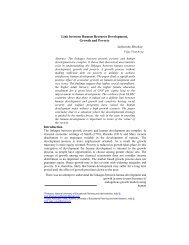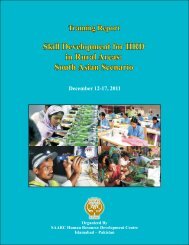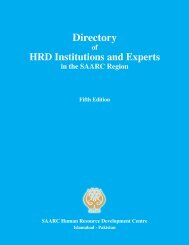Training Report: Millennium Development Goals in the SAARC Region
Training Report: Millennium Development Goals in the SAARC Region
Training Report: Millennium Development Goals in the SAARC Region
You also want an ePaper? Increase the reach of your titles
YUMPU automatically turns print PDFs into web optimized ePapers that Google loves.
Introduction<br />
policy <strong>in</strong>itiatives as usual are not enough to meet <strong>the</strong> MDGs. The <strong>SAARC</strong> Member States have to streng<strong>the</strong>n<br />
commitment to <strong>the</strong> MDGs through <strong>in</strong>tegration of <strong>the</strong> MDGs driven targets <strong>in</strong>to <strong>the</strong>ir national and sub-national<br />
policies and legal frameworks as well as <strong>in</strong> budgetary priorities. They need to ma<strong>in</strong>stream <strong>the</strong> MDGs with<strong>in</strong><br />
<strong>the</strong> policy-mak<strong>in</strong>g body of <strong>the</strong> government and establish <strong>the</strong> MDGs legislative committee to promote<br />
structural response. Fur<strong>the</strong>r, achiev<strong>in</strong>g progress towards <strong>the</strong> MDGs entails multi-pronged approaches<br />
<strong>in</strong>clud<strong>in</strong>g <strong>in</strong>clusive and susta<strong>in</strong>able growth, <strong>in</strong>vestment <strong>in</strong> anti-poverty programs, effective service delivery,<br />
adequate <strong>in</strong>vestment <strong>in</strong> education and health sectors, good governance, creat<strong>in</strong>g job opportunities, capacity<br />
build<strong>in</strong>g and fiscal stimulus for social expenditure.<br />
The <strong>SAARC</strong> Member States will also need to step up <strong>the</strong>ir efforts to replicate good practices and lessons learnt<br />
from early achievers <strong>in</strong> <strong>the</strong> region. <strong>Development</strong> partners of <strong>SAARC</strong> Member States are critical to <strong>the</strong><br />
achievement of <strong>the</strong> MDGs and must fulfil <strong>the</strong> requirement to help mobilize <strong>the</strong> required resources. Prospects<br />
for <strong>the</strong> region to achieve most of <strong>the</strong> objectives are bright. Keep<strong>in</strong>g <strong>in</strong> view <strong>the</strong>se prospects, a tra<strong>in</strong><strong>in</strong>g course<br />
is designed to assess <strong>the</strong> progress, prospects and way forward for <strong>SAARC</strong> Member States <strong>in</strong> achiev<strong>in</strong>g <strong>the</strong><br />
MDGs and propose policies and programs to achieve <strong>the</strong>se goals with <strong>the</strong> help of development partners. The<br />
one-week tra<strong>in</strong><strong>in</strong>g course will develop participants' knowledge and skills to assess <strong>the</strong> progress, prospects and<br />
way forward through various <strong>in</strong>-house exercises and group discussions.<br />
The objectives of <strong>the</strong> tra<strong>in</strong><strong>in</strong>g course were to:<br />
• assist senior policy makers, planners, and practitioners of <strong>the</strong> region to develop and implement <strong>the</strong><br />
MDGs-based national development strategies through shar<strong>in</strong>g of good practices and lessons learnt;<br />
• develop skills to help <strong>in</strong>tegration of <strong>the</strong> MDGs <strong>in</strong>to national development plans and strategies;<br />
• assess progress on implement<strong>in</strong>g <strong>the</strong> MDGs <strong>in</strong> <strong>the</strong> region;<br />
• discuss <strong>the</strong> constra<strong>in</strong>ts, challenges, prospects and way forward for achiev<strong>in</strong>g <strong>the</strong> MDGs <strong>in</strong> <strong>the</strong> region;<br />
• provide <strong>the</strong> participants with an opportunity to share experiences, best practices and propose policies<br />
and programs to achieve <strong>the</strong>se goals with <strong>the</strong> help of development partners;<br />
• suggest different ways and means for reach<strong>in</strong>g national and regional targets for meet<strong>in</strong>g <strong>the</strong> MDGs;<br />
and,<br />
• assess <strong>the</strong> public sector resources and needs for develop<strong>in</strong>g a global partnership for achiev<strong>in</strong>g <strong>the</strong><br />
targets as per commitment of 8th Goal of <strong>the</strong> MDGs.<br />
Methodology<br />
To achieve <strong>the</strong> tra<strong>in</strong><strong>in</strong>g objectives, a number of methodologies <strong>in</strong>clud<strong>in</strong>g lectures and demonstrations, peer<br />
work and group work were used. Resource persons arranged activities accord<strong>in</strong>g to <strong>the</strong> nature and<br />
requirement of <strong>the</strong>ir respective <strong>the</strong>mes to make <strong>the</strong> topics comprehensive and <strong>in</strong>terest<strong>in</strong>g for <strong>the</strong> participants.<br />
Each presentation was followed by a question-and-answer session <strong>in</strong> which participants asked questions and<br />
gave <strong>the</strong>ir <strong>in</strong>puts <strong>in</strong> relation to <strong>the</strong> topic under discussion. The participants came up with specific suggestions<br />
and recommendations related to <strong>the</strong> tra<strong>in</strong><strong>in</strong>g <strong>the</strong>me <strong>in</strong> <strong>the</strong> group works.<br />
Participants’ Profile<br />
Participants’ profile <strong>in</strong>cluded:<br />
a) Mid-level policymakers/functionaries, master tra<strong>in</strong>ers/professionals from government and<br />
semi-government organizations work<strong>in</strong>g <strong>in</strong> <strong>the</strong> areas of <strong>the</strong> MDGs, social sector<br />
development, HRD,<br />
plann<strong>in</strong>g and development, policy analysis and advocacy, and governance;<br />
b) Researchers and scholars on <strong>the</strong> MDGs as well as those work<strong>in</strong>g on HRD; and,<br />
c) NGOs and private sector representatives.<br />
Accord<strong>in</strong>g to Asia-Pacific <strong>Region</strong>al <strong>Report</strong> 2009/10, UNDP, a 1 % po<strong>in</strong>t fall <strong>in</strong> per-capita GDP growth translates on average, depend<strong>in</strong>g on <strong>the</strong><br />
country, <strong>in</strong>to a 0.5-0.8%po<strong>in</strong>ts decrease <strong>in</strong> growth of per capita private health spend<strong>in</strong>g, a 0.5-0.7% po<strong>in</strong>ts decrease <strong>in</strong> <strong>the</strong> growth of per capita public<br />
health spend<strong>in</strong>g, and a 0.3-0.5 % po<strong>in</strong>ts decrease <strong>in</strong> growth of per capita education spend<strong>in</strong>g.<br />
Melt-down <strong>in</strong> global economy <strong>in</strong> 2008 and sharp <strong>in</strong>crease <strong>in</strong> Oil prices early <strong>in</strong> 2008. This is likely to produce a double dividend-not only boost<strong>in</strong>g<br />
growth more rapidly but also accelerat<strong>in</strong>g progress toward <strong>the</strong> MDGs.<br />
2
















